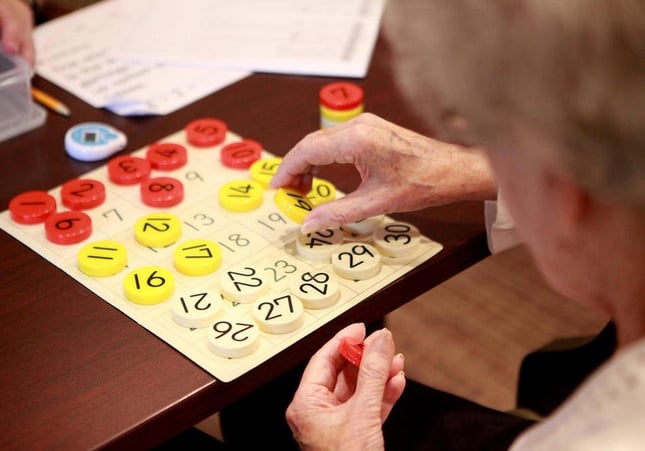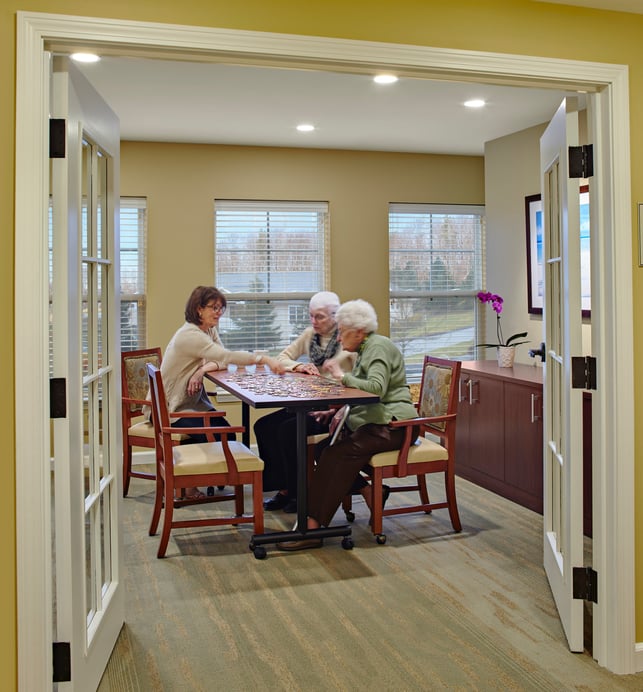
The number of families affected by Alzheimer’s is large and growing. According to the Alzheimer’s Association, more than 5 million Americans have the condition (69,000 of them here in Kentucky), with that number projected to grow to 16 million nationwide by the year 2050.
Alzheimer’s is the sixth leading cause of death in the Bluegrass. It’s estimated that looking after people with the disease cost Medicaid $664 million last year, and the value of unpaid care provided by family members is quickly approaching $4 billion a year.
But when we talk about “dementia care,” what exactly do we mean? What can memory support facilities, like Louisville’s Episcopal Church Home, do to help older loved ones living with Alzheimer’s, Parkinson’s, or other age-related cognitive disorders?
Here are 3 things you should know about modern Memory Care homes.
1. There’s no known cure for Alzheimer’s, but there are effective management techniques
Memory preservation treatments like SAIDO Learning are helping care centers to slow, or in some cases even arrest, memory loss. In fact, our partner organization, Episcopal Retirement Services, was one of the first care providers in North America to employ SAIDO Learning (at our Cincinnati sister community, Marjorie P. Lee Retirement Home) and it has achieved strong results with the program.
Another effective therapy for people with dementia is the facilitation of creativity, which can stimulate areas of the brain where long-term memories are coded and processed. Art and music therapy, in particular, are becoming more common treatments employed in the care of Alzheimer’s and dementia patients.
View More : SAIDO: Memory Preservation Treatments at ERS ⚫️ 🔴
In art therapy, a senior works one-on-one with a trained art therapist, or in facilitated group settings with other dementia patients, to produce simple paintings, clay sculptures, or drawings. For some patients, the tactile experience of creating art can spur higher-level thought, improve motor function and make recall easier.
In music therapy, a senior with dementia might either work with a licensed music therapist to create music, or be presented with personalized mixes of their favorite songs. Music is often a strong evoker of long-term memory, so playing or listening can promote better recall.
Music therapy is also highly effective for helping to stabilize dementia patients’ moods and prevent outbursts without the use of mood-altering medications.
2. Restraints are no longer commonly used
One of the biggest worries for family dementia caregivers is the tendency of an older loved one to wander. Wandering is a common symptom of dementia — especially in advanced cases — and can lead to serious injuries or even death.
In the past, some memory care facilities amounted to little more than a locked ward, and residents were often restrained — either by physical ties to their beds, or by psychotropic drugs — to prevent them from wandering about. Modern memory care homes are far more forward-thinking and compassionate.
A good memory care facility is designed
or adapted to allow safe wandering.
Today, a good memory care facility is designed or adapted to allow safe wandering. Hallways are wide and uncluttered. Grounds are enclosed. Residents are monitored, but aren’t physically or chemically restrained.
Some studies have shown that safe facilitation of wandering may actually keep areas of a dementia patient’s brain more engaged and active. So memory care facilities are now being designed with wide, brightly-lit, circular hallways and color-coded sections that help residents navigate without becoming completely disoriented or frustrated. Some homes employ remote sensors to help staffers keep tabs on wandering residents’ locations.
3. Memory care today is more proactive
In the past, memory care therapies were often reactive measures when symptoms presented themselves. But today’s memory care facilities focus on keeping residents happier and reducing dementia-related anxieties by keeping patients engaged with the world around them.
Memory care providers are now trained to work with a person’s dementia symptoms, rather than against them. If a resident can’t sit still or wanders during meal times, he or she might be given food that can be eaten while walking, or might be given headphones and an iPod loaded with a mix of soothing music, to help him or her focus.
At one Michigan memory care home, for example, residents assist in caring for a communal garden, which gives the more lucid among them a sense of purpose and helps to occupy and calm those with more advanced memory loss.
If your older loved one needs residential memory care, we’re here for your family.
Our retirement community in Louisville is one of Kentuckiana’s leading providers of compassionate, quality, residential dementia care. Click here to learn more about our memory support services and schedule your family’s tour today.













